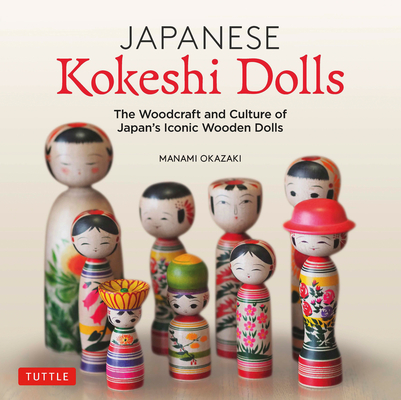An inside look at kokeshi dolls: from the skilled woodworkers behind their design to their important cultural significance. Discover the simplicity and charm of traditional Japanese Kokeshi dolls, known for their cylindrical shape and distinctive absence of arms and legs. Originally crafted as children's toys in Japan's Tohoku region, these dolls have evolved into sought-after collector's items, inspiring renowned architects and artists worldwide. In this visual guide, readers will find:An overview of the various Kokeshi doll typesHow kokeshi dolls are crafted, including information on tools and woods usedInterviews with leading kokeshi craftspeople worldwideDetailed information on both traditional and modern Kokeshi dollsAn exploration of the cultural significance, both historically and in the post-earthquake and tsunami rebuilding efforts of northern Japan in 2011A guide to visiting Japan's kokeshi regionsTips on purchasing these dolls directly from Japanese artisans or through global stockistsFilled with artist interviews, gorgeous photos and firsthand travel experience, author Manami Okazaki has created a book to be enjoyed by all — from serious collectors to woodcrafters, interior designers, architects, armchair travelers and anyone with an interest in Japanese culture and travel.
An inside look at kokeshi dolls: from the skilled woodworkers behind their design to their important cultural significance.Discover the simplicity and charm of traditional Japanese Kokeshi dolls, known for their cylindrical shape and distinctive absence of arms and legs. Originally crafted as children''s toys in Japan''s Tohoku region, these dolls have evolved into sought-after collector''s items, inspiring renowned architects and artists worldwide.
In this visual guide, readers will find:- An overview of the various Kokeshi doll types
- How kokeshi dolls are crafted, including information on tools and woods used
- Interviews with leading kokeshi craftspeople worldwide
- Detailed information on both traditional and modern Kokeshi dolls
- An exploration of the cultural significance, both historically and in the post-earthquake and tsunami rebuilding efforts of northern Japan in 2011
- A guide to visiting Japan''s kokeshi regions
- Tips on purchasing these dolls directly from Japanese artisans or through global stockists
Filled with artist interviews, gorgeous photos and firsthand travel experience, author Manami Okazaki has created a book to be enjoyed by all from serious collectors to woodcrafters, interior designers, architects, armchair travelers and anyone with an interest in Japanese culture and travel.
Get Japanese Kokeshi Dolls by at the best price and quality guranteed only at Werezi Africa largest book ecommerce store. The book was published by Tuttle Publishing and it has pages. Enjoy Shopping Best Offers & Deals on books Online from Werezi - Receive at your doorstep - Fast Delivery - Secure mode of Payment
 Jacket, Women
Jacket, Women
 Woolend Jacket
Woolend Jacket
 Western denim
Western denim
 Mini Dresss
Mini Dresss
 Jacket, Women
Jacket, Women
 Woolend Jacket
Woolend Jacket
 Western denim
Western denim
 Mini Dresss
Mini Dresss
 Jacket, Women
Jacket, Women
 Woolend Jacket
Woolend Jacket
 Western denim
Western denim
 Mini Dresss
Mini Dresss
 Jacket, Women
Jacket, Women
 Woolend Jacket
Woolend Jacket
 Western denim
Western denim
 Mini Dresss
Mini Dresss
 Jacket, Women
Jacket, Women
 Woolend Jacket
Woolend Jacket
 Western denim
Western denim
 Mini Dresss
Mini Dresss






























































